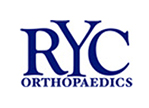Common Questions About Labral Tears
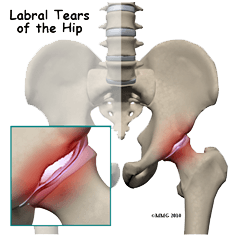
What is the labrum?
The hip is a ball and socket joint. The ball is made up of the top end of the thigh bone or femur. The socket is made up of the pelvis bone and is called the acetabulum. The labrum is a fibrocartilaginous structure on the rim of the socket which attaches in continuity with the articular cartilage of the socket.
What is the function of the labrum?
The labrum contributes to hip stability by deepening the socket and provides a seal of the hip joint.
Why does it tear?
The cause of a labral tear may be degenerative or traumatic. Degenerative tears occur after years of repetitive minor injuries and are usually associated with impingement or arthritis of the hip.
What is FAI or Femoroacetabular Impingement?
Femoroacetabular impingement is what predisposes patients to tearing their labrum. When the socket is shallow and the ball is uncovered, it is called hip dysplasia. When the socket is deep and the ball is prominent, it is called femoroacetabular impingement. Many individuals are born with hip architecture that exhibits prominent bone (spurs) over the socket and ball. When the ball moves within the socket, friction occurs at the interface because of the prominent bone on the ball and socket. This friction leads to labral tears, damage to the articular cartilage, and potentially osteoarthritis.
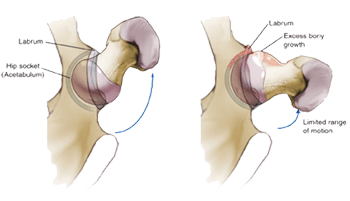
Why does it matter if the labrum is torn?
A torn labrum will not function normally in its role in enhancing joint stability and congruity. It can also be a source of significant pain and cause inflammation in the hip joint. The altered mechanics of the hip joint with a torn labrum may lead to early degenerative arthritis.
What are the symptoms of a torn labrum?
You may experience pain, sharp or dull, in the groin, on the outside of the hip, or buttock area during certain activities or certain movements of the hip joint. Sometime you may have pain sitting or getting into/out of a car. Occasionally, you may have a clicking or catching sensation.
How is it diagnosed?
Most patients can be diagnosed with a good history, physical exam, X-rays, and an MRI (sometimes an MR arthrogram which is an MRI with contrast injected into the joint is necessary). X-rays may be completely normal or may demonstrate signs of femoroacetabular impingement. If the diagnosis remains unclear, an intra-articular ultrasound guided hip injection is useful. The injection is performed with a local anesthetic such as lidocaine with or without cortisone. If the pain is relieved even for a few hours, the diagnosis of a labral tear may be confirmed. A CT scan may be useful to further analyze femoroacetabular impingement.
What other diagnoses might be confused with a labral tear?
- Lumbar spine pain (Low back pain)
- Lumbar radiculopathy (Low back pinched nerve, low back facet disease)
- Sacroiliitis (SI pain/dysfunction, back of pelvis)
- Trochanteric bursitis (Outside hip pain)
- Piriformis Syndrome (Back of hip pain)
- Iliopsoas tendonitis (Hip flexor inflammation)
- Groin pull
- Sports hernia (Abdominal muscle strain)
- Iliac apophysitis (Front of pelvis pain)
- Quadriceps hernia/strain (Thigh muscle pull)
What are the treatment options?
The treatment of labral tears in the hip is driven by the symptoms you experience. You may try non-operative treatments such as activity modification, physical therapy, and anti-inflammatory medications. Injections of steroid or viscosupplements (Hyalgan, Synvisc, Orthovisc) may also be attempted – but are usually not particularly effective.
If you are still symptomatic despite these non-operative treatments, you can undergo hip arthroscopy to treat the problem. During a hip arthroscopy, the labrum wil be repaired and any associated problems in the hip joint will be addressed. If there is associated femoroacetabular impingement, the prominent bone will be resected. This will decrease the chance of future damage to the labrum and the hip joint. If the labrum is torn beyond repair, it will be debrided.
What are the long term consequences of a labral tear?
We do not know for sure, but there seems to be a significant association between labral tears and arthritis in the hip – that is to say no study demonstrates a direct cause of arthritis by labral tears. It is impossible at this stage to predict who will develop symptomatic arthritis and who will not.
How long can I wait before seeking treatment?
Typically, if non-operative treatments fail to provide relief of your symptoms after 3-6 months, you should strongly consider surgery. A longer wait may compromise the cartilage of the hip.
If I don’t have my labral tear fixed, will I need a total hip replacement in the future?
Again, it is impossible to predict how severe the progression will be. Currently, there are several studies in progress assessing the long term complications of untreated labral tears.
My doctor told me that I should just have my labral tear cut out. Why should it be repaired?
Just as surgeons realized the importance of preserving the meniscus after decades of cutting out torn meniscal cartilage in the knee, recent literature has demonstrated that the labrum is a very important structure in the hip joint and every effort should be made to preserve the labrum.
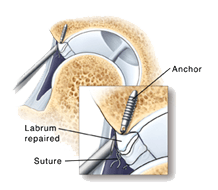
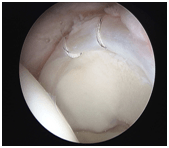
What are the main risks of hip arthroscopy?
- Complications are uncommon but include the following:
- Deep Venous Thrombosis (blood clot) – aspirin is given post-operatively
- Infection – antibiotics are given post-operatively
- Heterotopic ossification – (abnormal bone formation in soft tissues) – NSAIDs are given post-operatively
- Nerve injury (Sciatic, LFCN, Pudendal)
- Scarring/Adhesions
I tried activity modification and physical therapy and the pain continues, but I do not want to undergo surgery. Is there anything else I can try?
An intra-articular cortisone injection is an option. Cortisone is a strong anti-inflammatory that can temporarily improve symptoms. Cortisone will NOT repair a torn labrum. Some patients receive several months of relief, but others do not receive more than a few days of relief. It is not advisable to resume high impact activities if the cortisone injection decreases pain from the hip because of concerns of further damage to the torn labrum.
Regenerative medicine is an option for patients who have exhausted all treatment options and do not want to consider surgery. Platelet rich plasma (PRP) involves drawing blood from the patient’s vein, centrifuging the blood to concentrate plasma rich with platelets, and then injecting the concentrate into the hip joint. The platelets can signal the body to bring inflammation and healing to the area of the labral tear. A positive response can take four to six weeks. Stem cell therapy involves harvesting bone marrow or fat (adipose) cells. Stem cells are progenitor cells that become cartilage, bone, muscle, tendon, etc… Bone marrow aspiration (usually taken from the iliac crest) can provide millions of stem cells, which can be concentrated with a centrifuge, and then injected into the hip to provide regeneration and healing. Ultrasound guidance is used for precise injection of the PRP or stem cells into the hip joint.
PRP and stem cell therapy are safe because the products come from your own body. Regenerative medicine is currently not covered by commercial insurance plans. While there is no guarantee that regenerative medicine will heal tears of the labrum, patients may experience significant and lasting improvement from these injections. Extensive research has been done on regenerative medicine and continues to be performed.


